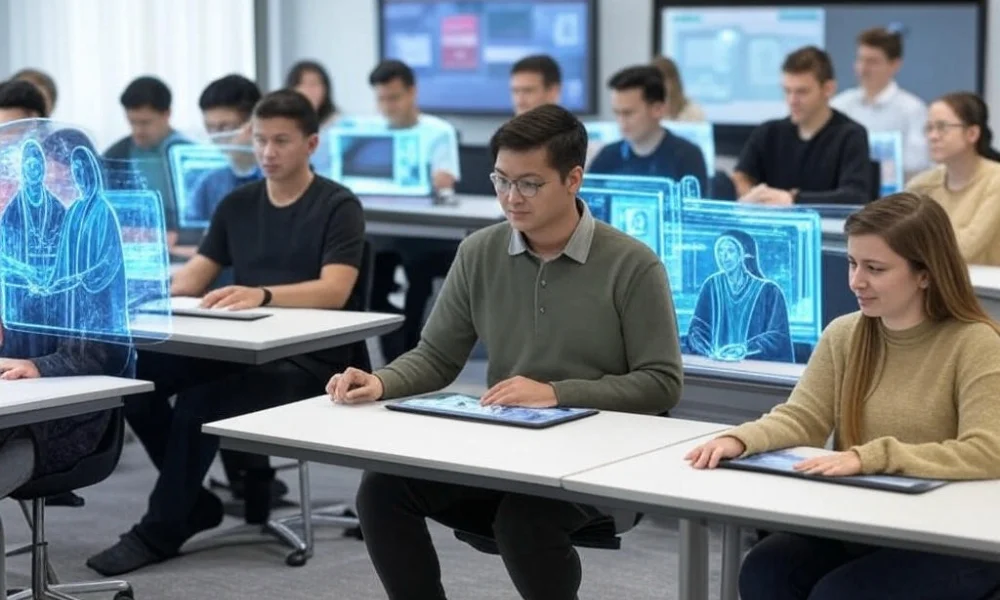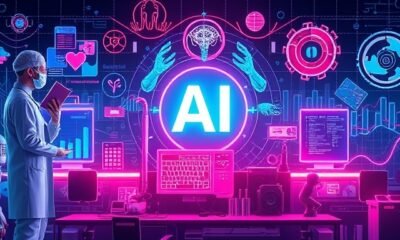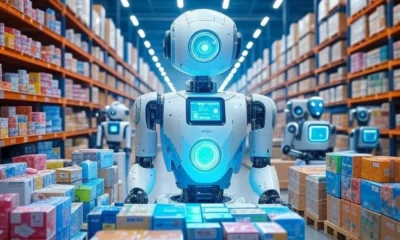Artificial Intelligence
AI Integration in Education: Executive Order Draft for K–12 Schools
AI is transforming K-12 education by personalizing learning, automating tasks, and making classrooms more inclusive. But with great potential comes significant challenges, including privacy concerns and unequal access.

Will artificial intelligence take over American schools to become their next classroom technology? The idea of introducing AI into the classroom stays on my mind continuously. Technology now influences our entire lives more than ever so it naturally follows schools are introducing higher levels of it. The United States government assesses a freshly composed executive order. This document suggests taking the next step of placing artificial intelligence systems into all US K-12 public classroom spaces.
This proposal creates both excitement and anxiety for us. People should debate how this change affects education players including students teachers and their parents.
Definition
Teachers and students use artificial intelligence technology to create customized experiences for learning and streamline educational responsibilities which lead to better student success.
The draft order wants to make education fit each student better while helping teachers work less and ensuring students succeed. Alongside my positive views exist crucial problems with this concept. What steps do we need to take when protecting students’ private information? Can you describe how conventional teaching practices will transform? Throughout this piece I explain the entire situation by examining both benefits and potential dangers of AI-based learning systems and their implications.
Draft Executive Order details its main features.
The government wants to achieve what with this executive order?
Our main target is to improve learning performance through AI education systems in K–12 schools. The plan lets students experience individualized teaching while fixing the differences between students. The order makes certain all students gain access to AI developments without exceptions. The plan deals with both data security and responsible AI management at school.
Plato Data Intelligence.
U.S. Department of Education
What steps will schools use to combine AI technology into their educational system?
The plan uses AI to make teaching sessions better plus grades systems yet adds tools for learning changes plus tracks student behavior. These systems exist to help teachers lessen their workload while giving students individualized educational plans. The integration aims to make educational processes better and more useful at the same time.
Who takes part in this implementation?
The government’s education department leads this project by working with school areas and AI technology providers while involving teachers’ unions and educators. Stakeholders from different sectors will create educational materials to help school districts use AI safely. Through partnership they want to make sure AI platforms benefit users in proper ways.
Whiteboard Advisors
When will the project begin and end?
The Department of Education needs 365 days to create detailed instructions on integrating AI into education. To help leaders effectively use AI in education they will build an AI toolkit as part of their work. The timeline gives enough time to prepare both key stakeholders and make needed plans to tackle any problems.
What Are The Advantages AI Brings To Teaching In School Years 12 And Under?
Student learning habits differ greatly from person to person. AI technology connects learning materials to what someone needs at the personal level.
The system deals with students based on their test results as well as their speed and studying preferences to help them continue learning.
With this backing every student finds better ways to excel either when they advance or need more time to learn.
What teaching functions can AI systems handle for instructors at school?
AI assists teacher assistants by processing homework evaluations and collecting student presentments.
The system suggests teaching plans that come from state requirements and match students’ learning progress.
AI lets teachers do more essential classroom teaching while saving them from administrative work.
System helps everyone connect to learning better.
I value this feature above all others in the technology. AI tools provide valuable assistance for students when dealing with disabilities.
Tools that convert speech to text plus graphic displays and translations eliminate learning barriers for students now.
All students deserve equal opportunities to learn which makes this development beneficial for everyone.
With factual evidence AI allows students to reach success.
- AI identifies students who face difficulty in learning based on their patterns but before test grades confirm it.
- The early alert system would likely decrease future learning obstacles.
- Using this system helps teachers partner with parents to support children when they need help at an early stage.
Will AI systems show unfavorable treatment against particular students?
The system appears neutral although human programmers developed its fundamental existence and human beings carry natural bias within themselves. My question is whether these systems learned from data that covered all student populations.
- Students from particular backgrounds would receive unequal evaluations because the system would not be properly updated.
- Meeting standard operating practices is necessary to stop unequal education from being magnified through AI systems.
- Honestly, no. Different schools demonstrate wide variations between available internet speed and working Wi-Fi access.
- The educational quality of artificial intelligence will fail to reach many students if we introduce the systems now.
Through AI technology education should unite students toward their potential by including every student regardless of financial background.
Will AI assist teachers in their role or gradually replace them completely?
Many teachers ask me this question today. All instructors understand the fear of becoming disposable in their workplace.
But AI isn’t a teacher. The device cannot match the motivational abilities of teachers who interact with students personally.
Proper deployment of AI technology should empower teachers to focus on their favorite teaching activities instead of forcing them out of class duties.
- The educational system reacts to AI by looking at its use in instruction.
- Tech supporters and educators look forward to AI because they see its value
- Most teachers accept AI because it cuts down their everyday work tasks. That’s a huge relief.
According to schoolteachers AI increases student involvement by delivering responsive instruction and personalized comments.
People who support technology predict artificial intelligence will improve classrooms to match digital learning systems before our students enter the workforce.
Learn from Real-Life Examples of AI in Education:
Which institutions from the United States have started using AI technologies for learning?
My findings show very unique outcomes. Frequent district evaluations with Khanmigo from the Khan Academy play a part in their testing practices.
This AI tutor assists students right away while suggesting teaching methods and showing teacher data through its system.
Students at these schools remain attentive throughout class and pose more education-related inquiries according to their teachers.
What specific approaches do different nations use to integrate AI educational systems?
Both South Korea and Singapore stand at the front of applying artificial intelligence technologies in education sector. Students are my main focus for research.
Singapore uses AI to find what students do not understand and creates practice questions with study suggestions.
South Korean education platforms automatically modify courses during classes according to their students’ learning speed and individual strengths.
What actual outcomes does AI produce that are noticeable?
Several educational establishments notice increased student interest along with enhanced test results primarily in mathematics and reading subjects.
Teachers at schools with AI assistances work closely with students instead of adopting a traditional teaching approach.
The existing data indicates that adding AI technology can enhance learning progress while improving student-teacher relationships.
What about schools without access to new technology?
My biggest issue stems from this matter. Every school building does not offer reliable internet connections or modern student devices.
Using AI now before building essential infrastructure will make poor districts remain far behind their wealthier peers.
Every school district should have equal opportunities to access learning technology regardless of students’ home addresses.
Our system needs a way to show if AI helps effectively without simply working automatically.
Ongoing assessments are a must. I want schools to monitor their data about the influence of AI in student test results as well as their commitment and fairness in learning.
Conclusion:
AI holds great potential for educational use in schools. The new technology offers personalized study paths plus better learning materials that let all students learn without limits. Real risks come along with this technology. Standard detection systems could prevent artificial intelligence benefits from delivering challenges to educational progress. The outcome of AI education systems depend on finding suitable solutions to both positive benefits and difficult issues.
Everyone must collaborate right now including school staff, parents, government officials and tech producers. Students need unbiased AI technology that helps their education without removing important teacher involvement.
AI can become a powerful learning tool for the 21st Century but only when humans provide acceptable controls beforehand.
What do you think? Is using Artificial Intelligence for learning better than taking the chance of major problems in education? Tell me your thoughts in the comment section and distribute this article to others who want to shape school evolution.
-

 Artificial Intelligence8 months ago
Artificial Intelligence8 months agoWhat is Artificial Intelligence? A Comprehensive Guide for Businesses and Enthusiasts
-

 Artificial Intelligence6 months ago
Artificial Intelligence6 months agoHow to Use Grok AI: A Complete Guide
-

 Artificial Intelligence8 months ago
Artificial Intelligence8 months agoUnlocking the Power of Artificial Intelligence Tools
-

 Artificial Intelligence7 months ago
Artificial Intelligence7 months agoWhat is DeepSeek? Revolutionizing AI with Cutting-Edge Solutions
-

 Artificial Intelligence3 months ago
Artificial Intelligence3 months agoAI Technologies in Warehouse Automation:
-

 Artificial Intelligence4 months ago
Artificial Intelligence4 months agoMeta’s AI Push: The Standalone Assistant App Set to Rival ChatGPT
-

 Artificial Intelligence3 months ago
Artificial Intelligence3 months agoHow Artificial Intelligence is Revolutionizing Logistics:
-

 Artificial Intelligence3 months ago
Artificial Intelligence3 months agoPredictive Analytics for Demand Forecasting:


